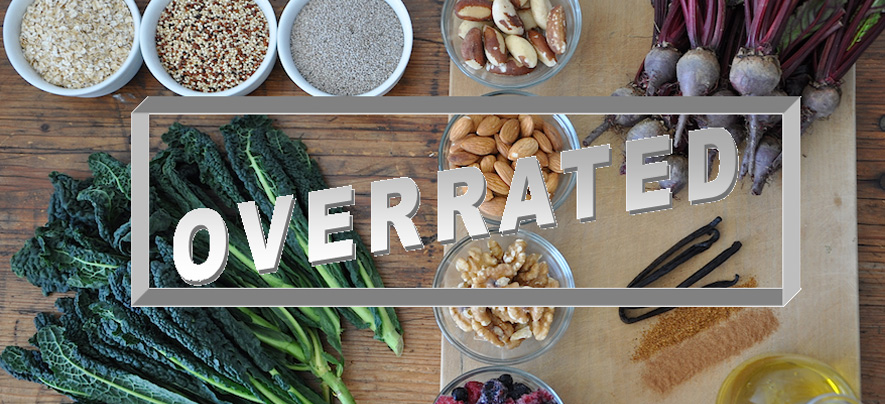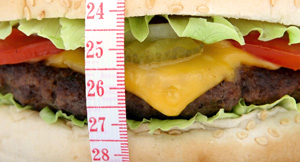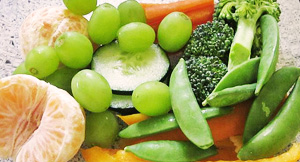Top 8 Overrated 'Healthy Foods'

Health & Lifestyle
458 week ago — 13 min read
There are so many words that are used to describe ‘healthy food’ now that I don’t blame you for getting confused! Superfoods, Clean Foods, Gluten Free, Low Fat, High Protein – really are all just another way for marketers to promote, and consumers to spend big! In reality, there are no ‘Superfoods’, and qualified nutritionists know better than to promote food other than as a whole food, which in itself has a variety of beneficial minerals and nutrients. So let’s take a look at some popular ‘healthy foods’ and what health benefits they may contain.
1. Coconut Oil
Coconut oil is marketed as a healthy oil composed of ‘good’ saturated fat. It is claimed that the saturated fat in coconut oil reduces LDL cholesterol levels. It is also claimed to prevent some chronic diseases like diabetes, heart diseases, chronic fatigue, hyperthyroidism, and irritable bowel syndrome.
Some Facts:
There generally is no good version of saturated fat. Polyunsaturated fat helps to lower the bad cholesterol levels. Coconut oil contains 92% saturated fat of its total fat content. If taken in large quantities on top of an already high fat diet, it may even raise cholesterol levels. Despite all the claims from ‘health gurus’, there is still not sufficient evidence to prove it can prevent diseases. Coconut oil has a strong flavour and slightly sweet taste, and although it is heat durable, it may not always be appropriate taste-wise, or health-wise for cooking every meal.
Healthy Alternatives:
Substitute good fat from oils rich in polyunsaturated or monounsaturated fat. A healthier alternative can be canola oil. Though the amount of calories and total fat is same (even slightly higher in canola oil), it contains 61% monounsaturated fat, 32% polyunsaturated fat and only 7% saturated fat which makes it a healthier option. Sunflower oil is rich in polyunsaturated fats with little flavour and a light colour. If refined it can be used for cooking. Unrefined it will break down at normal cooking temperatures. Olive oil is also rich in monounsaturated fat and can be used in both cooking, baking and for dressings. Extra virgin has a fruitier flavour and stronger aroma. Light olive oil is not lighter in calories, but lighter in colour and flavour making it a better baking choice.
2. Green Smoothies
Health conscious people use green smoothies as their ‘go to’, mainly because they can fit more greens and fruits in. Vegetables and fruit are a great source of vitamins and fibre, with little or no fat.
Some facts:
Nutritionists can agree on one thing: increasing the amount of fruits and vegetables in a diet is a better choice for long term, good health. Having a fruit and veggie smoothie in the morning is a also a good start for the day. But what happens when one smoothie turns into 3 per day? Or when one smoothie can contain at least 3-4 different types of fruits plus added honey/agave/raw sugar? What about the lack of added protein and healthy fats? We need to be conscious that smoothies can also strip out the filling fibre. So, a wiser opinion is to follow a balanced diet with plenty of fresh vegetables in their wholefood form, throughout the day with some added exercise.
Healthy Alternatives:
Try adding protein (powder, nuts, seeds, yogurt) and limit it to ½ or one fruit per serve, whilst also adding greens. This will also help with feeling fuller throughout the day and not snacking on other foods in between meals.
3. Breakfast Cereal
Granola, oats, whole grain wheat, quinoa are all examples of quick healthy breakfast options. These are considered healthy because they are good source of protein and fibre and may even help to keep you full.
Some facts:
High-protein cereals are great if they contain wholefoods such as nuts, seeds and rolled oats. But many prepackaged cereals are not high in protein, but higher in grains and combined with large amounts of sugar such as hydrogenated corn oil, palm oil, palm sugar , raw sugar, and honey, with some of them also not very high in fibre.
Healthy Alternatives:
Look for high fibre, low sugar options, or even better, source foods in their whole food form such as wholegrain rolled oats or quinoa. Read the label carefully to avoid any hidden unhealthy ingredient. Switch the milk to reduced fat. Add fruits for a touch of sweetness instead of sugar.
4. Rice Malt Syrup
Rice syrup is 100% glucose. Unless you are an athlete or training for an Olympic size marathon or triathlon, there is no need for this sweetener to be added to your diet, and unless you use that excess energy (burn the “empty calories”) it will be stored as fat, and may raise your blood sugar levels.
Some facts:
Although rice syrup is fructose-free, there is no other nutrition value in it. As rice syrup is processed from brown rice, this also increases the cost.
Healthy Alternatives:
Honey and pure maple syrup are alternative options. But in reality, the healthiest version of rice syrup is to simply reduce the amount consumed to very little, or none at all.
5. Fruit Juice
People consider fruit juice healthy generally because it contains fruit. But which is better for you - packaged fruit juice or homemade fruit juice?
Some Facts:
The truth is both options can be just as bad for you, if had in excess. Packaged juice contains preservatives and chemicals some of us can’t even pronounce, and in some cases not even a small percentage of real fruit! Alternatively, even if your fruit juice is 100% organic, homemade, and with no added chemicals at all, it may also not be a healthy snack option as it is simply fructose, meaning that our liver is working extra hard to process it, and it may not even sustain you for long. This is because we tend to put more fruit in the juice than we actually need, and in some cases, stripping it of its fibrous skin. Consider that the average adult should only need to consume 2 serves of fruit per day – how many pieces of fruit are in your freshly squeezed juice? The calories can add up and it also puts a lot of pressure on our liver to digest all the fructose consumed. If we don’t use the energy derived from excess fructose then this can turn into fat, which lodges in the liver (causing fatty liver and insulin resistance). Fruit juice also needs to be as fresh as possible to retain its nutrients.
Healthy Alternatives:
You can try vegetable juice, which contains a lower sugar content and in some cases fewer calories than fruit juice. For extra nutrients, and to keep you fuller for longer, you can try a mixture of fruits and vegetable drinks with added protein. Another good option is to simply eat the whole fruit instead of the juice.
6. Acai Berries
Acai berries are rich in antioxidants, and also more than some other types of berries. This is why people consider it as a healthier fruit and marketers call it a ‘super ood’. Some believe that it helps in anti-aging, weight loss and disease prevention.
Some Facts:
Diets high in antioxidants may help to prevent the onset of certain diseases such as cancers, Alzheimer’s disease, muscular degeneration and premature aging, and this is why, health professionals suggest to include fruits and vegetables high in antioxidants in our diet. Acai berries have gained in popularity for their high antioxidants properties. However, this is not necessarily the only source of antioxidants in food. Strawberries, citrus fruits, dark green veggies, orange to deep yellow fruits i.e. carrots, mangoes, apricots also contain antioxidants and may be less costly.
Healthy Alternatives:
Other great sources of antioxidants include broccoli, spinach, sweet potato, beans, and green tea, which may be more cost effective and also provide a large array of other essential nutrients.
7. Bulletproof Coffee
Claiming to promote weight loss and eliminate hunger pangs, Bulletproof coffee has grown in popularity among believers as a replacement to a wholefood breakfast, and the key to weight-loss. The recipe includes coffee, unsalted butter and MCT oil. BCP is also believed to boost energy and keep you fuller for longer.
Some Facts:
Some studies say that MCT oil has a mild positive effect on weight loss. Coffee without milk can also be a good source of energy. However, adding two tablespoons of butter and one tablespoon of MCT oil increases your saturated fat intake substantially – almost 140% over your recommended daily intake! A cup of Bulletproof coffee contains almost 300 calories, almost equivalent to one meal. There is also no substantial evidence to prove that having only fat and caffeine in the morning sets you up to burn fat for the rest of the day. Also, the coffee bean used for Bulletproof coffee is comparatively expensive and not much different to any other brand of coffee bean. According to some people, it keeps you full for up to 3-4 hours. Allowing yourself to be depleted of wholefoods for this long, may potentially cause you to overeat later in the day. This is therefore not a great option for cutting calories from your regular diet. However some people do feel that replacing the usual whipped-cream-topping-full-fat coffee with this no-sugar-no-milk-‘good-fat’ one is still a better option at any cost.
Healthy Alternatives:
Coffee with milk or black coffee, plus a protein filled breakfast in the form of a protein shake, eggs, oats, yogurt. If you do not drink coffee, then black tea and green tea, which is full of antioxidant Polyphenols, can also provide the caffeine boost.
8. ‘Gluten Free’ Packaged Foods
Gluten is a protein found in grains such as wheat, barley and rye. For some people (not suffering from a diagnosed gluten intolerance), it is a culprit for weight gain, skin irritations, and carbohydrate dependence just to name a few. Common beliefs of avoiding gluten are increased energy, lower cholesterol, weight loss, improved digestion, and better gastrointestinal function. As a result of this, manufacturers have seen an opportunity to monetize these speciality foods, and we are now seeing a lot more expensive (and sometimes unnecessary) gluten-free packaged foods in the supermarket shelves.
Some Facts:
People who suffer from Celiac disease (an autoimmune disease where the ingestion of gluten leads to damage in the small intestine) or Crohn’s disease (a chronic inflammatory disease of the intestine associated with ulcers and fistulae), need to avoid gluten in order to avoid further damage that gluten intake can cause including compromised nutrient absorption. Going gluten-free can be dangerous if you’re not careful about replacing nutrients you lose by omitting grains. Whole grains that contain gluten are a major source of fibre, vitamins, and minerals, and gluten-free diets risk being deficient in fibre, iron, niacin, and other nutrients. However, although some gluten-free foods are fortified with extra vitamins and nutrients, these foods can also be pricey. People who believe they have gluten sensitivity should consult a doctor to rule out other intestinal disorders.
Healthy Alternatives:
Replacement with gluten free grains such as quinoa and brown rice ensure you are not lacking in fibre, and still gaining protein, zinc, thiamine and B2. Both are also low in fat if cooked without added oils and sauces. Other non grain gluten-free options, include fruits, vegetables, lean meat and poultry, fish, nuts and dairy. For packaged food, look for gluten-free foods that are low in saturated fat, sugar and salt.
What are your alternatives to overrated healthy foods, and have you found it has changed your health for the better?
All the best!
Article & image source: http://execfuel.net/2015/09/09/our-top-8-overrated-healthy-foods/
Posted by
Karen AroneyAn accredited nutritionist, specializing in nutrition and better health for children, adults, time-poor professionals, and organizations. I use client-centric approach to enabling...
View Karen 's profile
SME Inspirations
Other articles written by Karen Aroney
5 Don'ts When it Comes to Your Nutrition
459 week ago
Most read this week
Trending
Entrepreneurship 1 week ago














Comments
Please login or Register to join the discussion